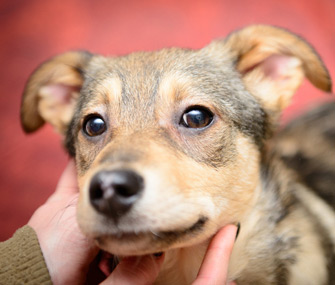Puppy Care 101: Tips for Eyes, Ears and Teeth
Published on June 13, 2016
Skip To

Eyes
Healthy eyes require very little attention except to use a moist cloth to clean away any crusts that may accumulate around them overnight. But this gives you a chance every day to check your dog’s eye health. Check that errant hairs or lashes are not touching the cornea (the clear outer surface of the eye) and causing irritation. If your dog has long facial hair, some strands may start rubbing his eyes, and you may need to clip the hair or carefully tie it back (make sure it’s not too tight).Some lid and lash disorders may become noticeable in puppyhood. In some cases, the lid turns in toward the eye, causing the eyelashes to brush against the cornea and irritate it. This condition, called entropion, may persist into adulthood and potentially need surgical correction, but in many cases it will go away as the dog’s face matures. See your veterinarian if one or both of your dog’s eyes appears to be causing discomfort.
Many eye problems cause a watery or mucous discharge. Some dogs have blocked tear ducts, so their tears drain out onto the face. Tears can cause the fur around the eyes to stain red. You may want to keep the face wiped clean to help prevent staining. Ask your veterinarian to check your dog’s eyes if he has tear staining.
Squinting or pawing at the eye can arise from pain. Swelling and redness may indicate a scratched cornea, or several other problems. Profuse tear discharge may be caused by a number of issues including a foreign body, scratched cornea or blocked tear duct. Any change in the pupil size of one eye, so that it differs from the pupil size of the other eye, could indicate a brain injury or other potentially serious problem.
If your veterinarian prescribes eye medication, wait until the puppy is drowsy and then tip his head back and place the drops or ointment in the inner corner of his eye. Follow with a treat immediately, so the pup associates positive things with the procedure.
Ears
Ear mites can be common in youngsters. They’re contagious, so separate a dog who has been diagnosed with them from other pets, but be aware that other pets may need treatment, too. Signs may include head shaking, scratching at the ears and a dark coffee-ground-like buildup in the ears. They itch like mad, so you need to see your veterinarian soon. Your veterinarian may prescribeAside from mite problems, most puppies have fairly healthy ears. Look as far inside them as you can to check for debris. A certain amount of wax is normal and serves a protective function in the ear, but if you see black or brown globs or the skin inside the ears appears red and your pup is scratching at the ears, he needs to be seen by your veterinarian.
Your veterinarian can diagnose the problem and show you how to clean the ears. Overzealous cleaning can actually contribute to the problem. Cotton swabs should be avoided, because they can rupture the eardrum or scratch the delicate lining of the ear, creating a foothold for bacteria and yeast. Your veterinarian can recommend an ear cleaner that’s right for your dog. Squirt the liquid in quickly (the slower it goes in the more it tickles) then gently massage it around the base of the ear. Let go and stand back while your dog shakes. (Do this outside!) Give a treat. Then do it again and wipe out the remaining moisture with a dry cotton ball or gauze. Give a treat. After the ear is cleaned, you can squeeze medicated ointment or drops into the canal, again gently massaging the ear base to disperse the prescribed medicine. And give a treat.
Teeth
Dental care begins in puppyhood, as you teach your puppy to tolerate getting his teeth brushed. At first, just get your puppy used to having your fingers in his mouth. Rub them along his teeth and give him a treat. Then cover your fingers with gauze and do the same thing. You’ll want to get a toothbrush that fits your puppy’s mouth. Since his mouth is probably small, you may want to try a finger brush, which you can get from a pet store or your veterinarian’s office. Also use doggy toothpaste, which comes in flavors that dogs tend to prefer, such as beef and poultry. Human toothpaste should be avoided, because the foaming agents can make your pup feel sick, plus human toothpaste can contain xylitol, a sugar substitute that is toxic to dogs.While you’re brushing, examine your puppy’s teeth to make sure a permanent tooth hasn’t come in next to a baby tooth that refuses to fall out. This happens most often with the large canine teeth — especially in Toy dogs. If both teeth stay, it can cause overcrowding. If you notice this problem, ask your veterinarian about it at your next visit.
More on Vetstreet:
- 7 Ways to Be a Better Dog Owner
- Pet Dental Health Myths Debunked
- 10 Strange Dog Behaviors Explained
- Does My Dog Really Need a Yearly Vet Visit?
- At-Home Guide to Brushing Your Pet’s Teeth





